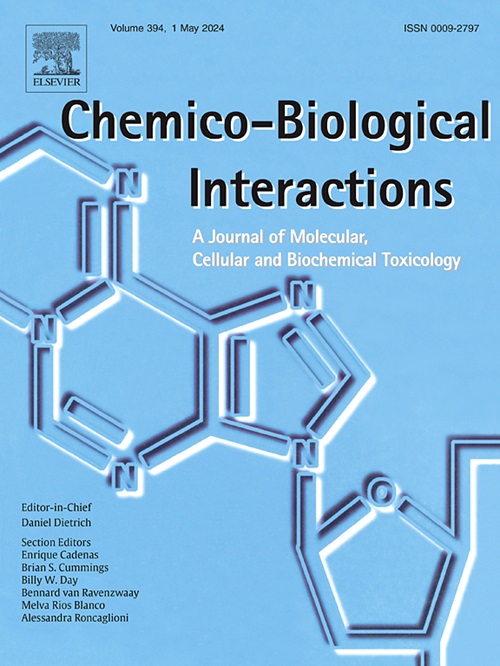基于NOX2/NLRP3炎性体信号通路探索熊果酸预防肝纤维化和改善肠道微生物群的机制
IF 4.7
2区 医学
Q1 BIOCHEMISTRY & MOLECULAR BIOLOGY
引用次数: 0
摘要
早期阶段的肝纤维化是可以逆转的;然而,人们对其基本机制仍不完全了解。肠道内有大量多样的微生物群,参与各种生理活动,与慢性肝病密切相关。以往的研究表明,从草本植物中提取的熊果酸(UA)具有抗炎和抗肝纤维化的特性,但其确切机制仍有待阐明。因此,利用蛋氨酸/胆碱缺乏(MCD)饮食和腹腔注射四氯化碳(CCl4)构建了肝纤维化模型。16S rRNA用于分析肠道微生物群。结果表明,UA减轻了肝损伤和肝纤维化,降低了与肝纤维化相关的指数,并降低了NADPH氧化酶2(NOX2)和NOD样受体蛋白3(NLRP3)的表达水平。与建模后的野生型(WT)小鼠相比,NOX2 和 NLRP3 基因敲除(NOX2-/- 和 NLRP3-/-)小鼠的肝纤维化有所缓解。然而,与模型敲除后的小鼠相比,UA 治疗和对照组治疗都不能明显改善肝纤维化。此外,NOX2-/-小鼠肝脏中的NLRP3表达水平较低。重要的是,与 WT 小鼠相比,基因敲除小鼠显示出更高的肠道微生物群多样性,其特点是有益菌增多,有害菌减少。总之,UA通过抑制NOX2/NLRP3炎性体信号通路发挥抗肝纤维化作用。通过调节这一信号通路,UA 有可能逆转肝纤维化,从而增强肠道微生物群。本文章由计算机程序翻译,如有差异,请以英文原文为准。
Exploring the mechanism of ursolic acid in preventing liver fibrosis and improving intestinal microbiota based on NOX2/NLRP3 inflammasome signaling pathway
Early-stage liver fibrosis can be reversed; however, the underlying mechanisms remain incompletely understood. The intestinal tract hosts a substantial and diverse microbiota involved in various physiological activities and is closely linked to chronic liver disease. Previous studies have indicated that ursolic acid (UA), derived from herbal plants, possesses anti-inflammatory and antifibrotic properties; however, its precise mechanism remains to be elucidated. Consequently, liver fibrosis models were constructed utilizing both the methionine/choline deficieny (MCD) diet and carbon tetrachloride (CCl4) intraperitoneal injections. 16S rRNA was conducted to analyze the intestinal microbiota. Results indicated that UA attenuated liver injury and fibrosis, reduced indices related to liver fibrosis, and decreased the expression levels of NADPH oxidase 2 (NOX2) and NOD like receptor protein 3 (NLRP3). Hepatic fibrosis was alleviated in post-model NOX2 and NLRP3 gene knockout (NOX2−/− and NLRP3−/−) mice in comparison to post-model wild-type (WT) mice. Nonetheless, neither UA treatment nor control treatment significantly improved liver fibrosis in comparison to post-model knockout mice. Furthermore, the liver of NOX2−/− mice exhibited lower levels of NLRP3 expression. Importantly, knockout mice displayed a higher diversity of intestinal microbiota, characterized by an increased presence of beneficial bacteria and a reduced presence of harmful bacteria compared to WT mice. In conclusion, UA exerts antifibrotic effects through the inhibition of the NOX2/NLRP3 inflammasome signaling pathway. UA has the potential to reverse liver fibrosis by modulating this signaling pathway, thereby enhancing the gut microbiota.
求助全文
通过发布文献求助,成功后即可免费获取论文全文。
去求助
来源期刊
CiteScore
7.70
自引率
3.90%
发文量
410
审稿时长
36 days
期刊介绍:
Chemico-Biological Interactions publishes research reports and review articles that examine the molecular, cellular, and/or biochemical basis of toxicologically relevant outcomes. Special emphasis is placed on toxicological mechanisms associated with interactions between chemicals and biological systems. Outcomes may include all traditional endpoints caused by synthetic or naturally occurring chemicals, both in vivo and in vitro. Endpoints of interest include, but are not limited to carcinogenesis, mutagenesis, respiratory toxicology, neurotoxicology, reproductive and developmental toxicology, and immunotoxicology.

 求助内容:
求助内容: 应助结果提醒方式:
应助结果提醒方式:


